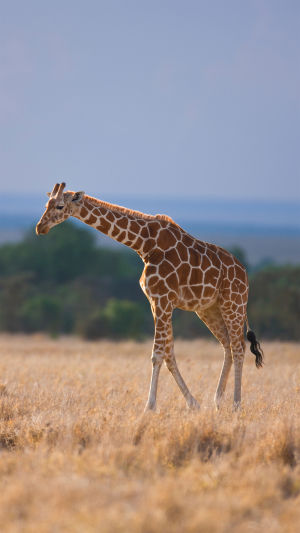The giraffe is a mammal that lives on the African continent and is currently the tallest terrestrial animal on the planet. The giraffe's body is tall, and its neck is therefore very long, reaching a length of 2-2.4 meters.
It generally has seven cervical vertebrae, each of which can reach a length of about 10 centimeters.
Giraffes do not have more cervical vertebrae than other vertebrates, but their length is the longest. In general, giraffes have thick and strong bones because they need their long necks to support their heads and bodies to reach enough food high up on tree branches.
The giraffe's neck also has a number of unique adaptive features. First, giraffes have two sets of very strong muscles in their necks that help them raise blood from their hearts to their heads, avoiding heat stroke and other health problems caused by gravity. Second, giraffes also have special ligaments in their necks that protect their cervical vertebrae from exposure to oxygen deprivation, twisting, and other injuries.
While giraffes are large enough to be noticeable, they are actually beneficial herbivores. Giraffes can make the most of the environment in which they live by selecting the tallest and driest leaves, flowers, and fruits in the jungle. In addition, their bodies have a specialized build that allows them to run at adult-like speeds and escape possible predators.
In addition to having a unique neck configuration, the rest of the giraffe's body parts are also very interesting. Giraffes have long, slender bodies with extra-long and very slender limbs that make them walk gracefully across the grasslands, seemingly at a gentle stroll.
The giraffe's head appears very small in relation to its body, and its eyes and ears are large, helping to monitor its surroundings and look for potential threats.
Giraffes have a special appearance and texture to their skin. Their skin shows a yellowish-brown to light brown mottled pattern, which gives them the advantage of stealth in the woods and allows them to blend in well with their environment. In addition, giraffes have very thick skin that protects them from plant thorns or other possible injuries.
Giraffes are also very interesting in their movements. A variety of behaviors have been observed in the wild. Sometimes they will quickly run across a savannah to feed, and sometimes they will raise their heads high as if to greet the sky.
Giraffe mating is also very unique, with males walking near females and then extending their long necks to accompany them before finally entering the mating stage.
In many African cultures, the giraffe is considered a sacred animal, representing elegance, freedom, and mystery. For the conservation of nature, it is all the more important that we study and understand these animals in-depth to better provide protection for giraffes and their habitats.
Although giraffes live in the wild, they are often disturbed and threatened by human activities. Human clearing, hunting, and forest destruction can all pose a threat to the giraffe's survival. To protect this precious species, many countries have undertaken conservation programs to allow giraffes to live and breed freely on the African continent again.





